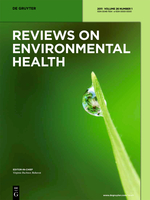Epidemiological Evidence for a Health Risk from Mobile Phone Base Stations
[Storica e fondamentale review che acclara il legame tra esposizione alle radiazioni emesse dalle stazioni radio-base di telefonia mobile e gli effetti biologico/sanitari sulla popolazione esposta, sino ad un raggio di 500 metri.
Elettrosensibilità e neoplasie sono le patologie correlate.]
INT J OCCUP ENVIRON HEALTH 2010;16:263–267
By:
VINI G. KHURANA, LENNART HARDELL, JORIS EVERAERT, ALICJA BORTKIEWICZ, MICHAEL CARLBERG, MIKKO AHONEN
Human populations are increasingly exposed to microwave/radiofrequency (RF) emissions from wireless communication technology, including mobile phones and their base stations. By searching PubMed, we identified a total of 10 epidemiological studies that assessed for putative health effects of mobile phone base stations. Seven of these studies explored the association between base station proximity and neurobehavioral effects and three investigated cancer. We found that eight of the 10 studies reported increased prevalence of adverse neurobehavioral symptoms or cancer in populations living at distances < 500 meters from base stations. None of the studies reported exposure above accepted international guidelines, suggesting that current guidelines may be inadequate in protecting the health of human populations. We believe that comprehensive epidemiological studies of longterm mobile phone base station exposure are urgently required to more definitively understand its health impact. Key words: base stations; electromagnetic field (EMF); epidemiology; health effects; mobile phone; radiofrequency (RF); electromagnetic radiation.
INTRODUCTION
Mobile phone base stations are now found ubiquitously in communities worldwide. They are frequently found near or on shops, homes, schools, daycare centers, and hospitals (Figure 1). The radiofrequency (RF) electromagnetic radiation from these base stations is regarded as being low power; however, their output is continuous. (1) This raises the question as to whether the health of people residing or working in close proximity to base stations is at any risk.
METHODS
By searching PubMed and using keywords such as base station, mast, electromagnetic field (EMF), radiofrequency (RF), epidemiology, health effects, mobile phone, and cell phone, and by searching the references of primary sources, we were able to find only 10 human population studies from seven countries that examined the health effects of mobile phone base stations. Seven of the studies explored the association between base station proximity and neurobehavioral symptoms via population-based questionnaires; the other three retrospectively explored the association between base station proximity and cancer via medical records. A meta-analysis based on this literature is not possible due to differences in study design, statistical measures/risk estimates, exposure categories, and endpoints/outcomes. The 10 studies are therefore summarized in chronological order (Table 1).
RESULTS AND DISCUSSION
We found epidemiological studies pertaining to the health effects of mobile phone base station RF emissions to be quite consistent in pointing to a possible adverse health impact. Eight of the 10 studies reported increased prevalence of adverse neurobehavioral symptoms or cancer in populations living at distances < 500 meters from base stations. The studies by Navarro et al., (2) Santini et al., (3) Gadzicka et al., (4) and Hutter et al. (5) reported differences in the distance-dependent prevalence of symptoms such as headache, impaired concentration, and irritability, while Abdel-Rassoul et al. (6) also found lower cognitive performance in individuals living ≤ 10 meters from base stations compared with the more distant control group. The studies by Eger et al. (7) and Wolf and Wolf (8) reported increased incidence of cancer in persons living for several years < 400 meters from base stations. By contrast, the large retrospective study by Meyer et al. (9) found no increased incidence of cancer near base stations in Bavaria. Blettner et al. (10) reported in Phase 1 of their study that more health problems were found closer to base stations, but in Phase 2 (11) concluded that measured EMF emissions were not related to adverse health effects (Table 1).
Each of the 10 studies reviewed by us had various strengths and limitations as summarized in Table 1. Pertaining to those base station studies in which EMF measurements were not carried out, (3,4,7,9) it should be noted that distance is not the most suitable classifier for exposure to RF-EMF. Antennae numbers and configurations, as well as the absorption and reflection of their fields by houses, trees, or other geographic hindrances may influence the exposure level. Further, self-estimation of distance to nearest base station is not the best predictor of exposure since the location of the closest base station is not always known. Such exposure misclassification inevitably biases any association towards null. Multiple testing might also produce spurious results if not adjusted for, (3,5) as might failure to adjust for participant age and gender. (7) Latency is also an important consideration in the context of cancer incidence following or during a putative environmental exposure. In this regard, the study by Meyer et al. (9) found no association between mobile phone base station exposure and cancer incidence, but had a relatively limited observation period of only two years. On the other hand, the studies by Eger et al. (7) and Wolf and Wolf8 found a significant association between mobile phone base station exposure and increased cancer incidence, although the approximate five-year latency between base station exposure and cancer diagnosis Other problems in several population-based questionnaires are the potential for bias, especially selection (8) and participation (2,3,5,6,11) biases, and self-reporting of outcomes in combination with the exposure assessment methods used. For example, regarding limitations in exposure assessment, in a large two-phase base station study from Germany,(12,13) of the Phase 1 participants (n = 30,047), only 1326 (4.4%) participated with a single “spot” EMF measurement recorded in the bedroom for Phase 2. Further, health effect contributions from all relevant EMF sources and other non-EMF environmental sources need to be taken into account. (12) We acknowledgethat participant concern instead of exposure could be the triggering factor of adverse health effects, however this “nocebo effect” does not appear to fully explain the findings. (4,5) Further, the biological relevance of the overall adverse findings (Table 1) is supported by the fact that some of the symptoms in these base-station studies have also been reported among mobile phone users, such as headaches, concentration difficulties, and sleep disorders. (13,14) Finally, none of the studies that found adverse health effects of base stations reported RF exposures above accepted international guidelines, the implication being that if such findings continue to be reproduced, current exposure standards are inadequate in protecting human populations. (15)
CONCLUSIONS
Despite variations in the design, size and quality of these studies as summarized in Table 1, it is the consistency of the base-station epidemiological literature from several countries that we find striking. In particular, the increased prevalence of adverse neurobehavioral symptoms or cancer in populations living at distances < 500 meters from base stations found in 80% of the available studies. It should be pointed out that the overall findings of health problems associated with base stations might be based on methodological weaknesses, especially since exposure to RF electromagnetic radiation was not always measured.
There are some proposed mechanisms via which low-intensity EMF might affect animal and human health, (16,17) but full comprehensive mechanisms still remain to be determined. (18,19) Despite this, the accumulating epidemiological literature pertaining to the health effects of mobile phones (13,20) and their base stations (Table 1) suggests that previous exposure standards based on the thermal effects of EMF should no longer be regarded as tenable. In August 2007, an international working group of scientists, researchers, and public health policy professionals (the BioInitiative Working Group) released its report on EMF and health. (21) It raised evidence-based concerns about the safety of existing public limits that regulate how much EMF is allowable from power lines, cellular phones, base stations, and many other sources of EMF exposure in daily life. The BioInitiative Report (21) provided detailed scientific information on health impacts when people were exposed to electromagnetic radiation hundreds or even thousands of times below limits currently established by the FCC and International Commission for Non-Ionizing Radiation Protection in Europe (ICNIRP). The authors reviewed more than 2000 scientific studies and reviews, and have concluded that: (1) the existing public safety limits are inadequate to protect public health; and (2) from a public health policy standpoint, new public safety limits and limits on further deployment of risky technologies are warranted based on the total weight of evidence. (21) A precautionary limit of 1 mW/m2 (0.1 microW/cm2 or 0.614 V/m) was suggested in Section 17 of the BioInitiative Report to be adopted for outdoor, cumulative RF exposure. (21) This limit is a cautious approximation based on the results of several human RF-EMF studies in which no substantial adverse effects on well being were found at low exposures akin to power densities of less than 0.5 – 1 mW/m2.2,5,22–26 RF-EMF exposure at distances > 500 m from the types of mobile phone base stations reviewed herein should fall below the precautionary limit of 0.614 V/m.
References
(1) Khurana VG, Teo C, Kundi M, Hardell L, Carlberg M. Cell phones and brain tumors: A review including the long-term epidemiologic data. Surg Neurol. 2009;72:205-214.
(2) Navarro EA, Segura J, Portolés M, Gómez-Perretta C. The microwave syndrome: A preliminary study in Spain. Electromag Biol Med. 2003;22:161–169.
(3) Santini R, Santini P, Le Ruz P, Danze JM, Seigne M. Survey study of people living in the vicinity of cellular phone base stations. Electromag Biol Med. 2003;22:41-49.
(4) Gadzicka E, Bortkiewicz A, Zmyslony M, Szymczak W, Szyjkowska A. Assessment of subjective complaints reported by
people living near mobile phone base stations [Abstract]. Biuletyn PTZE Warszawa. 2006;14:23-26.
(5) Hutter HP, Moshammer H, Wallner P, Kundi M. Subjective symptoms, sleeping problems, and cognitive performance in
subjects living near mobile phone base stations. Occup Environ Med. 2006;63:307-313.
(6) Abdel-Rassoul G, El-Fateh OA, Salem MA, Michael A, Farahat F, El-Batanouny M, Salem E. Neurobehavioral effects among inhabitants around mobile phone base stations. Neurotoxicology. 2007;28:434-440.
(7) Eger H, Hagen KU, Lucas B, Vogel P, Voit H. Einfluss der raumlichen nahe von mobilfunksendeanlagen auf die krebsinzidenz. [The influence of being physically near to a cell phone transmission mast on the incidence of cancer]. Umwelt-Medizin-Gesellschaft. 2004;17:326-332.
(8) Wolf R, Wolf D. Increased incidence of cancer near a cell-phone transmitter station. Int J Cancer Prev. 2004;1:123-128.
(9) Meyer M, Gartig-Daugs A, Radespiel-Troger M. Cellular telephone relay stations and cancer incidence. Umweltmed Forsch Prax. 2006;11:89-97.
(10) Blettner M, Schlehofer B, Breckenkamp J, Kowall B, Schmiedel S, Reis U, Potthoff P, Schüz J, Berg-Beckhoff G. Mobile phone base stations and adverse health effects: Phase 1 of a populationbased, cross-sectional study in Germany. Occup Environ Med. 2009;66:118-123.
(11) Berg-Beckhoff G, Blettner M, Kowall B, Breckenkamp J, Schlehofer B, Schmiedel S, Bornkessel C, Reis U, Potthoff P, Schüz J. Mobile phone base stations and adverse health effects: Phase 2 of a cross-sectional study with measured radio
frequency electromagnetic fields. Occup Environ Med. 2009; 66:124-130.
(12) Neubauer G, Feychting M, Hamnerius Y, Kheifets L, Kuster N, Ruiz I, Schüz J, Uberbacher R, Wiart J, Röösli M. Feasibility of future epidemiological studies on possible health effects of mobile phone base stations. Bioelectromagnetics. 2007;28:224-230.
(13) Khan MM. Adverse effects of excessive mobile phone us. Int J Occup Environ Health. 2008;21:289-293.
(14) Söderqvist F, Carlberg M, Hardell L. Use of wireless telephones and self-reported health symptoms: A population-based study among Swedish adolescents aged 15-19 years. Environ Health 2008;7:18.
(15) Hardell L, Sage C. Biological effects from electromagnetic field exposure and public exposure standards. Biomed Pharmacother. 2008;62:104-109.
(16) Salford LG, Nittby H, Brun A, Grafström G, Malmgren L, Sommarin M, Eberhardt J, Widegren B, Persson BRR. The mammalian brain in the electromagnetic fields designed by man with special reference to blood-brain barrier function, neuronal damage and possible physical mechanisms. Prog Theor Phys Suppl. 2008;173:283-309.
(17) Sheppard AR, Swicord ML, Balzano Q. Quantitative evaluations of mechanisms of radiofrequency interactions with biological molecules and processes. Health Phys. 2008;95:365-396.
(18) Khurana VG. Cell phone and DNA story overlooked studies. Science. 2008;322:1325.
(19) Yang Y, Jin X, Yan C, Tian Y, Tang J, Shen X. Case-only study of interactions between DNA repair genes (hMLH1, APEX1, MGMT, XRCC1 and XPD) and low-frequency electromagnetic fields in childhood acute leukemia. Leuk Lymphoma. 2008; 49:2344-2350.
(20) Hardell L, Carlberg M, Soderqvist F, Hansson Mild K. Metaanalysis of long-term mobile phone users and the association with brain tumours. Int J Oncol. 2008;32:1097-1103.
(21) Sage C, Carpenter D, eds. BioInitiative Report: A rationale for a biologically-based public exposure standard for electromagnetic fields (ELF and RF) [Internet]. 2007 [cited April 3, 2009]. Available from: http://www.bioinitiative.org.
(22) Kundi M, Hutter HP. Mobile phone base stations – Effects on wellbeing and health. Pathophysiol. 2009;16:123-35.
(23) Henrich S, Ossig A, Schlittmeier S, Hellbrück J. Elektromagnetische Felder einer UMTS-Mobilfunkbasisstation und
mögliche Auswirkungen auf die Befindlichkeit—eine experimentelle Felduntersuchung [Electromagnetic fields of a UMTS
mobile phone base station and possible effects on health – results from an experimental field study]. Umwelt Med Forsch Prax. 2007;12:171-180.
(24) Thomas S, Kühnlein A, Heinrich S, Praml G, Nowak D, von Kries R, Radon K. Personal exposure to mobile phone frequencies and well-being in adults: A cross-sectional study based on dosimetry. Bioelectromagnetics. 2008;29:463-470.
(25) Zwamborn APM, Vossen SHJA, van Leersum BJAM, Ouwens MA, Makel WN. Effects of global communication system radiofrequency fields on well being and cognitive functions of human subjects with and without subjective complaints. Organization for Applied Scientific Research (TNO), Physics and Electronics Laboratory: The Hague, Netherlands, 2003.
(26) Regel SJ, Negovetic S, Röösli M, Berdinas V, Schuderer J, Huss A, Lott U, Kuster N, Achermann P. UMTS base station like exposure, well being and cognitive performance. Environ Health Perspect. 2006;114:1270-1275.
Versione PDF integrale scaricabile al seguente link:





